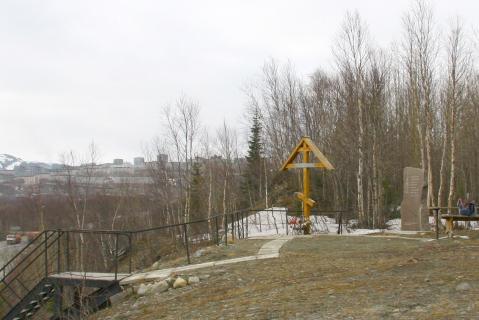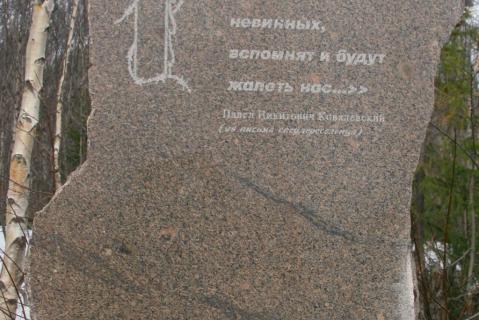In 1930 “special settlers”, for the most part dekulakized peasant families, were sent to build the Apatite combine and the town of Khibinogorsk (pop. 10,000 in 1930; renamed Kirovsk in 1934). In the early 1930s the death rate among the exiles was high. They were buried in a plot next to the Apatity-Kirovsk highway at the 16th kilometre. Subsequently, the site became the city cemetery. Burials from the early 1930s have been partially preserved. The total number buried there has not been established; the names on surviving grave-markers are preserved in lists of forced settlers.
*
In 1989, the Khibin branch of Memorial erected a wooden cross in memory of the victims of political repression at the graveyard. In 2005, a stone monument was erected next to the cross on 30 October by Memorial in memory of the forced settlers who died in avalanches in 1935 and 1938. Both memorials form part of the same commemorative area.
The monument bears an epigraph from Paley Kovalevsky’s Letter from a forced settler: “A day shall come when I’m no longer here / that people will remember and pity us, / innocent labourers.”
NOTE By 1989, Kirovsk had a population of 43,526. It has since declined [2011?] to 28,625.
Volume Two of the Murmansk Region Book of Remembrance, 1930s-1950s (2005, 413 pp) deals specifically with the 29,000 forced settlers and deportees sent to the Kola Peninsula.
The Memorial online database (2025) names 2,147 who were deported to Kirovsk and 296 children of forced settlers who were born there.
Drawing on police records the database lists 36,311 victims in the Murmansk Region. They include 30,073 deportees, the majority of whom – 24,190 – were sent to the Murmansk Region from other parts of the USSR.
| Date | Nature of ceremonies | Organiser or responsible person | Participants | Frequency |
|---|---|---|---|---|
|
30 October
|
Remembrance Day for the Victims of Political Repression
|
Khibin Memorial Society
|
Memorial, Kirovsk administration
|
Annual event
|
| State of burials | Area | Boundaries |
|---|---|---|
|
Early 1930s burials partially preserved
|
Not established
|
Unmarked
|
[ Original texts & hyperlinks ]
Khibin Memorial society, The part played by special settlers and prisoners in opening up the Khibin area: A book of memoirs, Apatity, 1997
Ye.V. Vasilyeva, “Burial sites in the Kirovsk-Apatite district of the Murmansk Region: their history and present condition”, Proceedings of the Kola Research Centre (Russian Academy of Sciences), 2010, No 2
Virtual Museum of the Gulag, “Mass grave of special settlers at the 16th km cemetery (Apatity-Kirovsk highway)” [retrieved, 28 May 2022; no longer accessible]
*
Letter from Irina Flige, director of RIC Memorial (No 1231 of 25 March 2014) to Marina Kovtun, governor of the Murmansk Region {in English}
Reply by the Kirovsk town administration (№ 01-845 of 18 April 2014) to a formal enquiry from RIC Memorial (St Petersburg)


